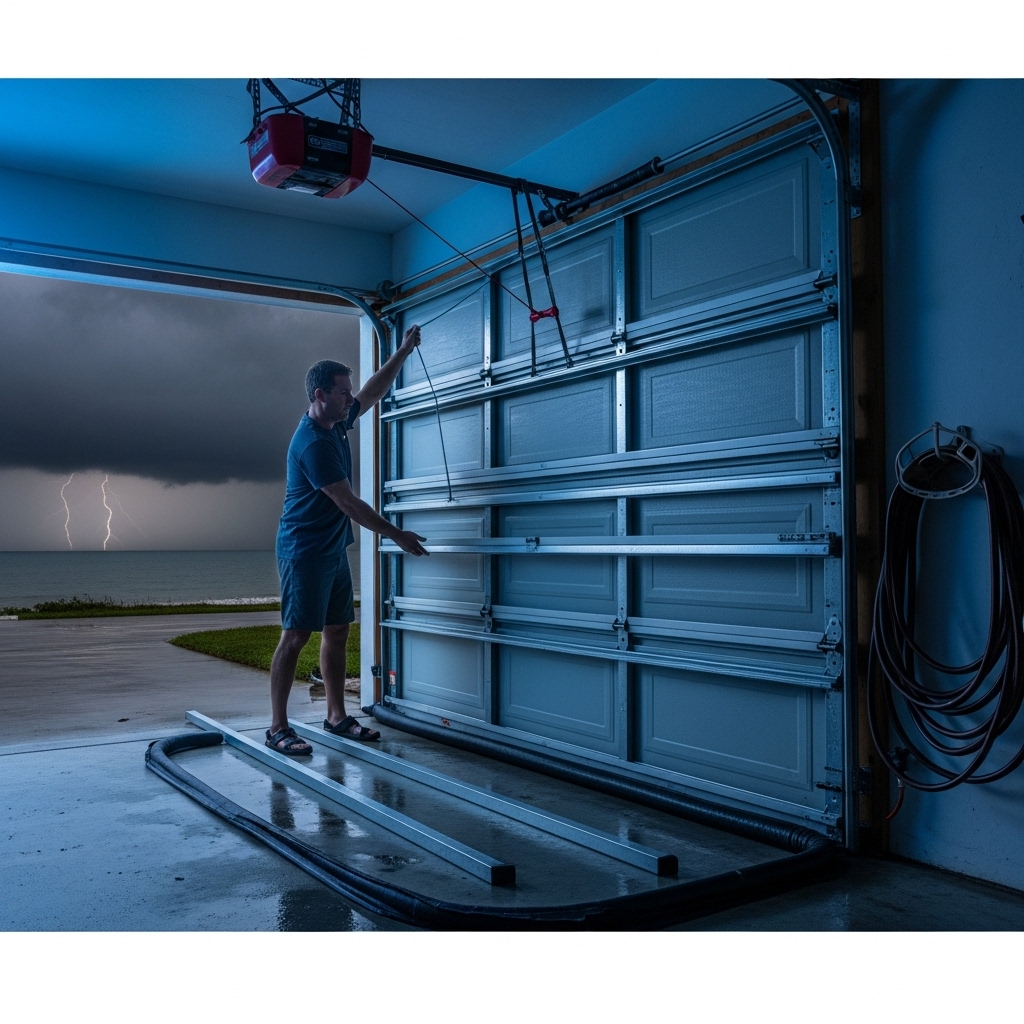Seasonal storms in Florida place extraordinary stress on garage doors. High winds, flying debris, rapid pressure changes, and power interruptions can turn a minor weakness into a major failure. The garage door is often the largest moving opening in a home, and when properly prepared it becomes a strong barrier that helps protect your property. This guide gives you a practical, step-by-step checklist to prepare before the season, actions to take when a storm is approaching, and what to inspect after the weather clears. If you are building your plan for the first time, consider scheduling a professional evaluation and routine garage door service to confirm the door, hardware, and opener are ready for the conditions common in your area.
Use the following checklists to prepare your door for wind, water, and electrical disruptions. Even a well-maintained system can suffer if one weak component is overlooked, so take a methodical approach.
Pre-Season Preparation Checklist
Complete these steps before storm season begins so the door and opener start in top condition.
- Verify wind rating: Confirm that your door meets your jurisdiction’s wind-load requirements, including appropriate reinforcement struts and mounting hardware.
- Inspect tracks and fasteners: Ensure tracks are straight, plumb, and firmly anchored to solid structure with correct bolts and brackets.
- Check springs and cables: Look for rust, fraying, or elongated coils. Replace worn components proactively to prevent failure under wind stress.
- Lubricate and balance: Apply light lubricant to hinges and rollers, then test door balance with the opener disconnected. A properly balanced door reduces strain on hardware during storms.
- Weather seals and thresholds: Replace brittle or cracked bottom and perimeter seals to limit wind-driven rain and debris intrusion.
- Opener health and settings: Test safety reverse, verify travel limits, and ensure the opener runs smoothly without grinding or surging.
- Battery backup and manual release: Confirm the battery backup is functional and that every adult in the household knows how to use the manual release safely.
- Surge protection: Install quality surge protection for the opener. Lightning and grid fluctuations are common in Florida storms.
- Smart alerts and notifications: Enable app-based alerts to confirm the door is closed as storms approach.
48–24 Hours Before the Storm
As forecasts become clearer, focus on reinforcing the system, organizing access, and reducing hazards.
- Close and lock the door: Engage any manual locks or slide bolts if your door design includes them.
- Clear the area: Move vehicles, bins, and tools away from tracks and door sweep areas to prevent obstructions.
- Protect sensors: Ensure photo eyes are aligned and secure so an accidental bump does not disable the system when you need it most.
- Confirm power backup: Verify your opener’s battery backup is charged.
- Inspect for loose items: Tighten any rattling track bolts, hinge screws, and opener mounting hardware.
During the Storm
Your best move during severe weather is to keep the door closed and locked. Avoid operating the door in high winds to prevent track distortion or panel damage. If the power goes out, resist the temptation to repeatedly cycle the system when power returns; surges can damage electronics. Wait until conditions stabilize, then test carefully.
Post-Storm Inspection Checklist
After the storm has passed and it is safe to go outside, carefully evaluate each part of the system before returning to daily use.
- Visual survey: Look for bent tracks, loose brackets, missing fasteners, and panel damage.
- Operate manually first: With the opener disengaged, lift the door by hand to check smoothness. Do not force a binding door; investigate and correct the cause.
- Check cable seating: Make sure cables are properly seated on drums and not frayed or kinked.
- Test safety devices: Reconnect the opener, test photo eyes, and verify that the door reverses upon contact.
- Inspect weather seals: Replace damaged seals to keep out residual moisture and pests.
- Electronics evaluation: Check surge protectors and confirm the opener is not emitting unusual odors or error codes.
Upgrades That Strengthen Storm Resilience
Consider improvements that make your system more robust when the weather turns severe.
- Impact- or wind-rated doors: Choose models that meet your county’s design pressures and local requirements.
- Heavy-duty track and hardware: Thicker-gauge tracks and brackets, properly anchored, resist deformation in wind events.
- Reinforcement struts: Installed across panels to distribute loads and reduce flexing.
- Corrosion-resistant components: Galvanized or stainless hardware, powder-coated springs, and sealed bearings resist Florida’s humidity and salt air.
- Battery backup and smart controls: Maintain access during outages and verify door status remotely.
Common Mistakes to Avoid
Even well-intentioned steps can create risk if done incorrectly. Avoid these pitfalls:
- Bracing the door with makeshift lumber that interferes with tracks or binds the panels.
- Disabling safety sensors to force operation when the cause of reversal is not addressed.
- Over-lubricating tracks, which attracts grit and increases friction.
- Ignoring small alignment issues that become major under wind load.
Professional Support: When to Call
Any sign of spring damage, frayed cables, or significant track movement warrants professional evaluation. If the door becomes uneven or will not stay mid-span during a balance test, stop using it. A trained technician can reset balance, realign tracks, verify fastener engagement into sound structure, and confirm compliance with local wind-load requirements. Proactive mid-season inspections are especially helpful in Florida, where frequent storms can gradually shift components over time. If you want a stress-free season, schedule comprehensive garage door service before the first major weather system approaches.
Frequently Asked Questions
Q: How do I know if my door is wind-rated for my area?
A: Look for labels or documentation indicating design pressures and approvals. Your local provider can verify whether the door meets your jurisdiction’s requirements.
Q: Should I unplug my opener during a storm?
A: Surge protection is important, but many homeowners keep the opener powered to use battery backup features and maintain remote control. Use a quality surge protector and follow manufacturer guidance.
Q: How often should I replace weather seals in Florida?
A: Inspect seals annually and replace them when cracked, flattened, or brittle. Intense sun and heat can shorten seal life near coastal and southern exposures.
Q: Can I reinforce an existing door to meet higher wind loads?
A: Often, yes—through reinforcement struts, upgraded tracks and brackets, and improved anchoring to structure. A professional should evaluate whether upgrades can bring the system into compliance.
Q: What is the safest way to use the manual release?
A: Only pull the release when the door is closed, and make sure the path is clear. If the door is open, support it securely before disengaging the opener.
Be Ready Before the Next Storm Arrives
Preparation reduces risk, speeds recovery, and keeps daily life on track even when the weather turns rough. Build your checklist, gather supplies, and schedule a pre-season professional garage door service so your system is ready to perform when it matters most.

